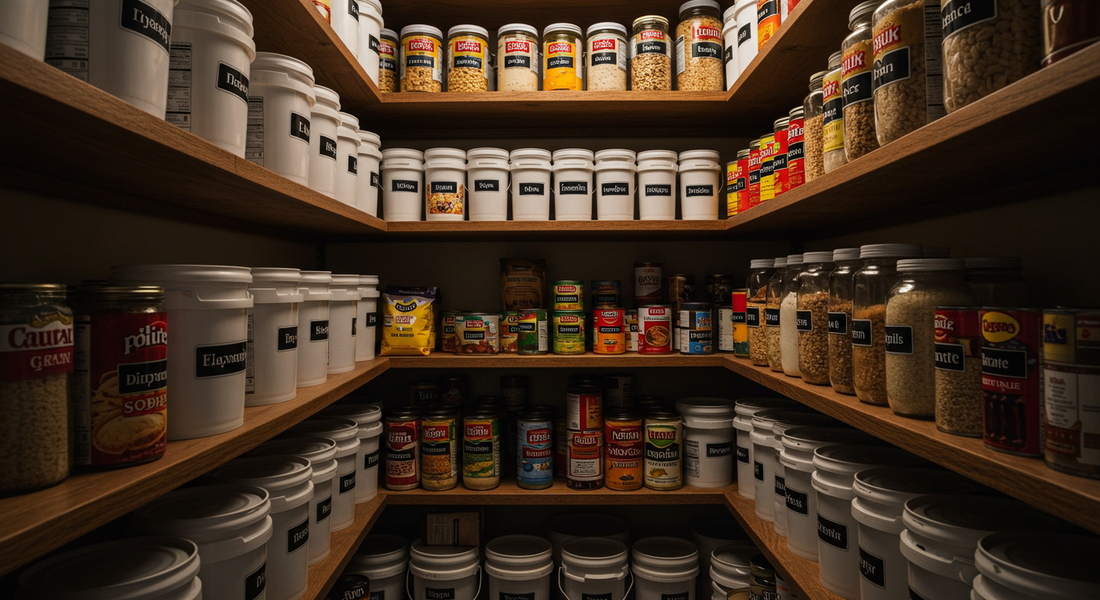
A Beginner's Guide to Long-Term Food Storage
Share
In an unpredictable world, the ability to provide for yourself and your family is the ultimate form of security. At the heart of this self-reliance is food preparedness, a practical discipline that ensures you have a stable food supply regardless of external circumstances. The goal of food security is to build a resilient pantry, a well-stocked reserve that can sustain you through anything from a personal job loss to a natural disaster. This guide is designed to introduce you to the core principles of long-term food storage, a critical component of any serious preparedness plan.
Many people are familiar with short-term food storage, which typically involves having a 3-day to 3-month supply of the foods you eat regularly. This is an excellent first step. However, long-term food storage is a different endeavor altogether. It focuses on building a supply that can last for one year, five years, or even decades. This requires selecting specific types of food that are known for their exceptional shelf stability and using precise storage techniques to preserve their nutritional value and safety over extended periods. Understanding this distinction is the first step toward building a truly robust emergency food supply.
The Enemies of Food Storage
Before you can learn how to store emergency food effectively, you must understand what you are protecting it from. There are five primary enemies that will degrade your food supply, rendering it unpalatable or unsafe to eat. Mastering the defense against these elements is fundamental to successful long-term storage.
-
Oxygen: Oxygen is essential for life, but it's a major adversary to stored food. It causes oxidative decay, which leads to the degradation of vitamins, fats, and flavors. When fats oxidize, they become rancid, creating off-flavors and odors. For long-term preservation, removing as much oxygen as possible from your food containers is non-negotiable.
-
Moisture: Water is another essential for life, which is why it's a primary catalyst for spoilage. Moisture allows for the growth of microorganisms like mold, yeast, and bacteria. For dry goods, the ideal moisture content is 10% or less. Any higher, and you risk turning your investment into a science experiment. Therefore, protecting your stored food from ambient humidity and any potential water exposure is critical.
-
Light: Sunlight and even artificial light can have a surprisingly damaging effect on stored food. Light, particularly in the UV spectrum, accelerates the breakdown of sensitive vitamins like A, D, and E, and can cause fats to go rancid more quickly. It also leads to fading colors and altered flavors. Storing food in opaque containers in a dark location is a simple but vital rule.
-
Temperature: Heat is an accelerant. It speeds up the chemical reactions that cause food to spoil. The cooler the storage area, the longer your food will last. The ideal temperature for long-term food storage is consistently cool, ideally between 40-60°F (4-15°C). Avoid storing food in places with wide temperature fluctuations, such as garages or attics, as the constant expansion and contraction can compromise container seals.
-
Pests: Rodents and insects can destroy a food supply with astonishing speed. Not only do they consume the food, but they also contaminate it with their waste, posing a significant health risk. Using durable, airtight, and rodent-proof containers is your primary line of defense against these unwelcome pantry guests.
Best Foods for Long-Term Storage
Choosing the right foods is the cornerstone of a successful storage plan. The best options are nutrient-dense, calorie-rich, and have a proven track record of lasting for years, if not decades, when stored properly.
-
Dry Staples: These are the foundation of any long-term pantry. They are affordable, versatile, and have an incredibly long shelf life.
-
White Rice: When stored correctly, white rice can last for 30 years or more. Avoid brown rice for long-term storage, as its higher oil content will cause it to go rancid within a year.
-
Dried Beans: Pinto, black, kidney, and other dried beans are packed with protein and fiber and can last for 30+ years.
-
Rolled Oats: An excellent source of calories and nutrients, rolled oats can be stored for up to 30 years.
-
Pasta: Pasta is another carbohydrate-rich staple that can last for decades if kept dry and sealed.
-
-
Freeze-Dried and Dehydrated Meals: This is where commercially prepared survival food buckets shine. The freeze-drying process removes nearly all the water from the food, making it incredibly lightweight and shelf-stable for 25 years or more. These meals offer variety and convenience, providing complete dishes that only require water to rehydrate. While more expensive than bulk dry staples, they are an invaluable part of a well-rounded plan, especially for emergency situations where cooking complex meals may be difficult.
-
Canned Goods: Commercially canned goods offer an excellent mid-term storage solution, typically lasting 2-5 years past their "best by" date if stored in a cool, dark place. They are convenient and ready-to-eat, making them perfect for shorter-term emergencies. Focus on high-protein items like canned meats (tuna, chicken, spam), soups, stews, fruits, and vegetables.

Having the right foods is only half the battle. Using the proper materials and methods is what ensures they will still be viable when you need them. These three items are the holy trinity of food preparedness basics.
-
Food-Grade Buckets: These are typically 5 or 6-gallon plastic buckets made from HDPE (high-density polyethylene), a plastic that is safe for direct food contact. They are your primary defense against pests and physical damage. Always ensure any bucket you use is designated as "food-grade." For long-term storage, they are often paired with a Gamma Seal Lid, which is a two-piece lid system that creates a screw-on, airtight, and watertight seal, making access easier than with traditional pry-off lids.
-
Mylar Bags: Mylar is a brand name for a type of stretched polyester film. For food storage, these bags are laminated with aluminum, creating a barrier that is impervious to light, moisture, and oxygen. Food is placed inside the Mylar bag, which is then heat-sealed shut. This creates a protected micro-environment for the food inside the larger bucket.
-
Oxygen Absorbers: These are small packets containing iron powder. When placed inside a sealed Mylar bag, they absorb virtually all the free oxygen (typically over 99.9%), preventing oxidation and the growth of aerobic microorganisms. Using an appropriately sized oxygen absorber for your Mylar bag is one of the most critical steps in preserving your food for the long haul.

Getting Started: A Practical Approach
Building a substantial food supply can feel overwhelming. The key is to start small and be consistent. You don't need to buy a year's worth of food overnight.
-
"First In, First Out" (FIFO) Rotation System: This is a fundamental principle of pantry management. When you add new items to your storage, place them at the back. When you use items, take them from the front. This ensures that you are always using your oldest stock first, which prevents food from expiring and going to waste. While less critical for 30-year staples, it's a vital habit for managing your canned goods and other items with shorter shelf lives.
-
The "Buy One for Now, Two for the Pantry" Method: This is one of the simplest and most affordable ways to begin. Every time you go grocery shopping, identify a long-lasting item on your list that your family regularly eats (like pasta, canned tuna, or rice). Instead of buying just one, buy three. One is for your immediate use, and the other two go into your long-term storage. This incremental approach spreads the cost over time and allows you to build a significant supply almost without noticing.
Pro Tip: Create a simple inventory list. A spreadsheet or a notebook will do. Every time you add items, log the product, quantity, and date of purchase. This prevents you from overbuying certain items while neglecting others and gives you an accurate picture of your supply at a glance.
